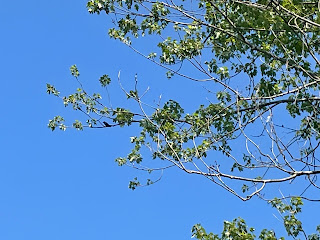7/18 at 5:15 p.m. It is super humid and muggy from the recent heavy rain. There is no wind to an occasional, slight wind. The main sound I can hear is that of insects with their chirps and buzzing. They dominate over the birds. The mosquitoes are trying to feast on me. There are also sounds of trucks driving nearby. I came upon feathers belonging to a Gray Catbird.
NEW SPECIES
Swamp Cicada (Neotibicen tibicen)
The insect sound at my site that is greater than the buzzing mosquitoes is the Swamp Cicada, also known as the Morning Cicada. These harmless insects are found in the eastern and central United States, as well as parts of southeastern Canada. They are in the order Hemiptera. The loud buzzing sound they make is from the males to attract the females. The females lay their eggs in tree branches and when they hatch, the larva burrows underground and feed off of the sap of the tree roots. Eventually, they come above ground and molt into adult form. Their habitat includes weeds, shrubs, swamps, marshes, fields, and meadows. Various animals that enjoy a Swamp Cicada include raccoons, dogs, birds, and lizards. Even the occasional human has been known to try them. They taste like popcorn.
Writer, S. (2022, January 6). Swamp cicada. Insect Identification for the casual observer. Retrieved July 22, 2022, from https://www.insectidentification.org/insect-description.php?identification=Swamp-Cicada
Smooth Bromegrass (Bromus inermis)
Smooth bromegrass was introduced by Hungary in the late 1800s. It is a cool season grass with the identifying characteristic of a watermark in the shape of a W, which is found midway between the collar and the leaf blade tip. It is a drought-tolerant grass that prefers silty to clay loam but can grow just fine in sandy soils too. This plant, when grown with red clover and alfalfa is a great food source for hay and pasture. Its tough root system makes it useful for ground cover and preventing soil erosion.
Roberts , C. (2000, May). Smooth bromegrass. University of Missouri Extension. Retrieved July 23, 2022, from https://extension.missouri.edu/publications/g4672
Early Goldenrod (Solidago juncea)
Early Goldenrod, like its name suggests, blooms the earliest. Not only does it grow in meadows, like my site, Mary's Meadow, but can also be found in various types of prairies, abandoned fields, thickets, and places that get a lot of sunlight. It is not picky about the type of soil it will grow in. Many insects like to pollinate the Early Goldenrod flower, including various flies, bees, butterflies, beetles, and moths. The Early Goldenrod can be distinguished from other goldenrods because it has very little to no hair on the stems and leaves.
Early Goldenrod. Early goldenrod (solidago juncea). (2022). Retrieved July 23, 2022, from http://www.illinoiswildflowers.info/prairie/plantx/er_goldenrodx.htm
Allegheny Blackberry (Rubus allegheniensis)

This plant also goes by the names Blackberry, Common Blackberry, Dewberry, and Graves' blackberry. This plant can be found most often in forests, meadows, and woodlands. It grows well in full sun to light shade in fertile soil. It can also grow in rocky soil or clay loam. Many types of insects are attracted to the flower's sweet nectar and pollen and many mammals and birds enjoy the berries it produces. I know I like them! Some animals will try to browse on the leaves, but get deterred by the thorns and prickles.
NC State Extension. (2022). Rubus allegheniensis. Rubus allegheniensis (Allegheny Blackberry, Blackberry, Common Blackberry, Dewberry, Graves' blackberry) | North Carolina Extension Gardener Plant Toolbox. Retrieved July 23, 2022, from https://plants.ces.ncsu.edu/plants/rubus-allegheniensis/
7/7/19 at 6:20 a.m. I was inspired to greet the morning sun and to see what my life around my site would be like. More insects, but also lots of birdsong. The next 4 pictures are a progression of the sun hitting some trees on my site.




MORNING BUG AND BIRD CHORUS:Buzz buzz buzz buzzBUZZ, BUZZ“creep, creep, creep, creep”Buzz, buzzPee-oo-wee, Pee-oo-weeBuzz, buzzLook-up, over-here, see-me, up-hereBuzz, buzz, buzzPeter, peter, peterBuzz, buzz, buzzMeow, meowBuzz, buzz,Here I am, over here, see me, where are youBuzz, buzz, buzz, buzz, buzz, buzz, buzzHere, here, hereBuzz, buzzTeer, teeer, teer, jeer-deert, teer!Bu-U-U-U-U-uzYank, yank, yankBuzz, buzzSweet, sweet, chew, chew, see-it, see-itBuzzBuzzBuzzBuzzBuzzBuzzBuzz
This poem consists of the birdsong on my site featuring: Pewee, Indigo Bunting, Tufted Titmouse, Red-eyed Vireo, White-breasted Nuthatch, Gray Catbird, and the Great Crested Flycatcher.
Schmalz, G. (2022). Mnemonics. Retrieved July 23, 2022, from http://www.fernbank.edu/birding/mnemonics.htm
*QUESTION OF THE WEEK*
What are the soils like in the habitat and
how does it influence plants or other organisms on my site?
I took two soil samples:
The soil sample below was taken from a dried-up vernal pool. It was a darker brown color than the soil sample I took from the path going through my site. However, it looks a little lighter here because of the lighting. The soil texture consisted of sand, silt, and a bit more clay than the other soil I gathered.
The soil I collected from the path is a dark brown color, but not quite as dark as the soil from the dried-up vernal pool. It consists of first sand, then silt, with the least amount being clay. This soil is packed full of vegetation including many forbs and grasses found in prairies. This soil looks a little darker because it was damp when I first gathered it.
The plants on my site are not really picky as to the soil consistency, grow well on this type of soil, as long as it is well-drained, and have deep root systems.
As I was leaving my site I heard an Indigo Bunting in the tree above me.
Do you see his silhouette on the middle left?
















No comments:
Post a Comment